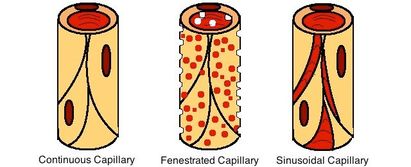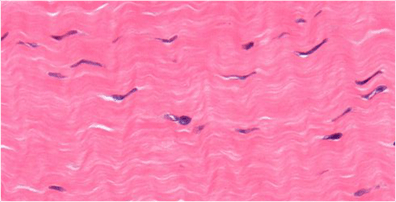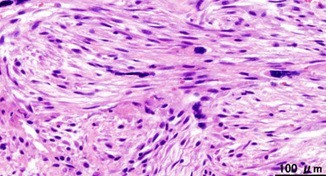Most tissues in the body have a blood supply (some, like SPINAL DISCS do not), and the more metabolically active the tissue is, the better its blood supply will be. Blood flows away from the heart via arteries, which branch and narrow into the smaller arteries called arterioles, and then branch further still into the capillaries. After the tissue has been perfused with oxygen carried by the red blood cells, the capillaries join and widen to become venules. They then widen to become veins, which return blood to the heart to become oxygenated once more. Just remember that individual capillaries in the capillary bed are so small that only one blood cell at a time can get through them — single file. The capillary bed is where gas exchange in the tissue takes place. CO2 (Carbon Dioxide — a byproduct of Cell Metabolism) is traded for O2 (Oxygen — needed for Cell Metabolism).
An important concept to remember is that you cannot injure the tissue without injuring the tissue’s capillary bed as well. Because these capillaries are quite thin, they can be torn or broken relatively easily. Let’s say that you were hit in the thigh by a line drive baseball while pitching to your son. As the tissue was impacted, it deformed / stretched. This is normal and good. Unfortunately, the blow by the baseball was too intense and occured too quickly for the soft tissues in your thigh to overcome the mechanical stresses / load placed upon it. In other words, the tissue tore.
Bear in mind that usually this “tissue tearing” is something that occurs microscopically. In other words, testing with advanced imaging techniques (MRI, CT, Diagnostic Ultrasound) might show some swelling, but are not likely to show the tissue damage itself — even though it was the tissue damage that caused the swelling to occur.

Capillaries are not solid tubes. They have tiny “holes” (some smaller than others) to allow water and other substances in and out. When the baseball impacts your thigh and TEARS THE FASCIA or INJURIES TO THE MUSCLE, the capillaries that make up the soft tissue’s capillary bed are also torn. If they are torn just a little bit, you might get just a little bit of swelling, and little or no bruising. If the tissue is really damaged, then the capillary beds will be more severely disrupted. What this means is that you will have a lot of fluid leaking out of the blood vessel into the surrounding tissue.
When this happens, there are chemical mediators that are released (INFLAMMATION) which, while not to be considered swelling, attract swelling to them via vasodilation. In other words, these mediators we call Inflammation can actually make the blood vessel dilate to a larger size! As you can imagine, the worse the tissue injury, the worse the swelling. And the worse the swelling, the more things that can go wrong. Some of this is because the initial Swelling and Inflammation is the first step in forming SCAR TISSUE. This is why it is important to control swelling. Oh, and by the way, when the capillaries are torn enough, they can actually leak red blood cells into the fluid around the tissue (Interstitial Fluid). This is called a BRUISE. The best way to control the swelling and inflammation (remember, these two are not synonymous) is to use ice. Cold takes dilated vessels and begins to “constrict” them in a process opposite vaso-dilation, called vaso-constriction. This not only helps slow the amount of swelling and inflammation flooding into the area, it helps slow down the amount of red blood cells leaking into the area as well. Although the old (40 year old) information said to use ice the first 24 hours and heat after that; this is bad advice.
My advice is to only use heat for old (chronic) injuries and then use it systemically —- whole body heat in the form of a bath, shower, jacuzzi, etc. Local heat has the potential to cause lots of problems. Instead use ice. Just be smart about how you do it. No more than 10-20 minutes (depending on the area being treated) and never directly on the skin. One more thing. Even though anti-inflammatories work, they have lots of potentially serious side-effects, which is why we recommend ice instead of drugs!
BREAKING MICROSCOPIC ADHESIONS,
SCAR TISSUE, AND TISSUE FIBROSIS
As I explained to you earlier, the first step in Scar Tissue Formation is swelling and inflammation. The chemicals that we collectively refer to as “Inflammation” attract proteins to the area to repair it. Unless you are going through specific active rehabilitation with your injury (and often times even if you are), your body is going to heal the injury with a scar. Bear in mind that the scars I am talking about are microscopically small (they will not show up on MRI or CT scans), but can be incredibly restrictive as far as joint motion is concerned. If you simply compare the microscopic pictures of the Connective Tissue below, you will see the organized, waviness of the normal tissue; compared to the unorganized, swirled, mess in the picture of the scar.


WHY BREAKING SCAR TISSUE CAUSES BRUISING
This is quite easy to understand. Even though scar tissue is not optimal tissue and we would like to get rid of it, or at the very least “remodel” it; it is a living tissue with a capillary bed. Often times (usually), the “Controlled Trauma” that characterizes our Tissue Remodeling Therapy breaks these capillary beds as it breaks down the Scar Tissue, Fibrosis, TENDINOSIS, and FASCIAL ADHESIONS. You can see pictures of some of our patient’s bruises (HERE). Do not fear the bruise, but embrace it! It will actually help you get better. Oh, and you should probably be using ice on the area as well. And in order to get the area to heal like we want it to heal (without a scar), you will need to do some intense STRETCHING as well.
